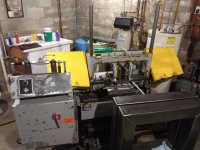Jashley73
Titanium
- Joined
- Jan 24, 2013
- Location
- Louisville, KY
I've got a customer that makes some parts out of Hadfield Manganese Steel, 12-14% manganese content I believe. They made the comment one day about it being impossible to cut on a bandsaw, and of course --- challenge accepted...
Today we began testing on a piece of 2" round, with a 4-6tpi bi-metal blade, but with M51 HSS teeth instead of the standard M42...
The customer expected us to ruin the blade instantly. We made it half-way through before stopping the trial due to slow performance, however the blade was technically still cutting. To confirm this, we removed the manganese material, and made another cut through 2" round 1045, to confirm that the saw teeth were still in OK condition.
In the Manganese material, the blade began to wander as we reached the full 2" width of cut. It was however still making chips, but they grew increasingly fine. We were using coolant - which looked like a full synthetic coolant based on look & feel. The material & blade never got hot.
I think we ran out of head-weight, and simply couldn't penetrate the material anymore. The saw is a smaller, but very nice condition "Wells" dual-column saw. However, I think it's simply a gravity feed/hydraulic bleed-off feed control, and we simply ran our of weight.
I'm thinking about going to a courser-pitch blade in order apply more force to each tooth given our limited head-weight. I'm on the fence about using coolant or not. I know that D2 saws better dry vs. with coolant, and I'm not sure if the Manganese would be in the same boat.
I'm going to reach out to the sawblade manufacturer tomorrow to determine the next course of action, but I wanted to poll the PM crowd to see if anyone has had success band-sawing this material.
Thanks in advance.
Today we began testing on a piece of 2" round, with a 4-6tpi bi-metal blade, but with M51 HSS teeth instead of the standard M42...
The customer expected us to ruin the blade instantly. We made it half-way through before stopping the trial due to slow performance, however the blade was technically still cutting. To confirm this, we removed the manganese material, and made another cut through 2" round 1045, to confirm that the saw teeth were still in OK condition.
In the Manganese material, the blade began to wander as we reached the full 2" width of cut. It was however still making chips, but they grew increasingly fine. We were using coolant - which looked like a full synthetic coolant based on look & feel. The material & blade never got hot.
I think we ran out of head-weight, and simply couldn't penetrate the material anymore. The saw is a smaller, but very nice condition "Wells" dual-column saw. However, I think it's simply a gravity feed/hydraulic bleed-off feed control, and we simply ran our of weight.
I'm thinking about going to a courser-pitch blade in order apply more force to each tooth given our limited head-weight. I'm on the fence about using coolant or not. I know that D2 saws better dry vs. with coolant, and I'm not sure if the Manganese would be in the same boat.
I'm going to reach out to the sawblade manufacturer tomorrow to determine the next course of action, but I wanted to poll the PM crowd to see if anyone has had success band-sawing this material.
Thanks in advance.




 You can call me Hu, or you can call me Dung, or you can call me HuFlung, or you can all me Flungdung, but ya doesn't have to call me Mister
You can call me Hu, or you can call me Dung, or you can call me HuFlung, or you can all me Flungdung, but ya doesn't have to call me Mister 
